FAU WiSo Oase – Sustainability Meets Inspiration
A symbol for the city – the Nuremberg paving slab
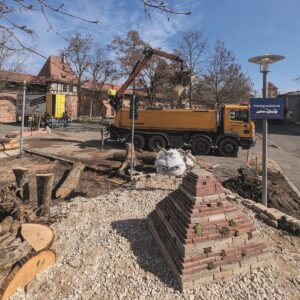 The Nuremberg paving slab, an icon in its own right, sits unobtrusively and yet omnipresent on the paths of this city. With an attentive gaze, its presence is easily recognized, as hardly any sidewalk remains untouched by its beauty. Yet it does not radiate loudly, but in quiet serenity, an introverted force, reliable and resilient. A city of Nuremberg without it is hardly conceivable. This monument, which consists largely of her, is dedicated to this silent heroine of everyday life. Created from the slab that provides solid ground underfoot: the Nuremberg sidewalk slab.
The Nuremberg paving slab, an icon in its own right, sits unobtrusively and yet omnipresent on the paths of this city. With an attentive gaze, its presence is easily recognized, as hardly any sidewalk remains untouched by its beauty. Yet it does not radiate loudly, but in quiet serenity, an introverted force, reliable and resilient. A city of Nuremberg without it is hardly conceivable. This monument, which consists largely of her, is dedicated to this silent heroine of everyday life. Created from the slab that provides solid ground underfoot: the Nuremberg sidewalk slab.
A stone pyramid like this not only serves as an aesthetic highlight and landmark in the area, but also offers numerous ecological benefits. Birds, for example, use it as an elevated and safe perch, while insects and spiders find shelter in it. The southern area of the pyramid creates ideal conditions for heat-loving plants, while the northern area provides pleasant shade in summer.
Incidentally, the red clinker bricks were left over from the FAU WiSo’s new building and, like the paving slabs, were upcycled.
Unimagined biodiversity – the flower meadow and the sandy grassland
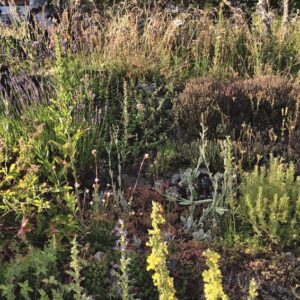 It may seem irritating at first, but the greatest biodiversity is found on poor soils. A wealth of valuable and important flowering and forage plants thrive on these soils, which are an important source of food for numerous hungry pollinators. Over 1,300 native plants prefer a humus-poor soil.
It may seem irritating at first, but the greatest biodiversity is found on poor soils. A wealth of valuable and important flowering and forage plants thrive on these soils, which are an important source of food for numerous hungry pollinators. Over 1,300 native plants prefer a humus-poor soil.
Many gardens today are dominated by unnaturally nutrient-rich or over-fertilized soils. These monotonous green areas do not provide a suitable habitat for most insect species. A wildflower meadow, on the other hand, is not only an aesthetic enrichment, but also an important basis of life for numerous animals and plants. It provides living space, hiding places and food. Each individual plant species attracts certain animals. A high biodiversity of plants therefore also means a high diversity of animals, especially insects.
In order to promote biodiversity, the soil in this bed was deliberately depleted. This was done by removing the topsoil and then filling it with gravel, which could also be recycled from the former construction site storage area. A mixture of native wild perennials was then sown
which, with a little patience, will grow into a magnificent flower meadow.
Hidden habitat – the clay wall and the sandarium
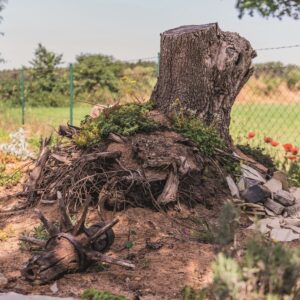 Around 75 percent of all wild bees are ground-nesting species. They find their nesting sites in steep walls, demolition edges and even in old house walls built with lime mortar or abandoned clay and sand pits. These specialized bees and solitary wasps dig their own nest tunnels. The willow sand bee, for example, digs its brood cavities in the sand and lays its eggs there. Species such as the spring silk bee and the ivy silk bee, which is active in late summer, also need open sandy areas to lay their eggs.
Around 75 percent of all wild bees are ground-nesting species. They find their nesting sites in steep walls, demolition edges and even in old house walls built with lime mortar or abandoned clay and sand pits. These specialized bees and solitary wasps dig their own nest tunnels. The willow sand bee, for example, digs its brood cavities in the sand and lays its eggs there. Species such as the spring silk bee and the ivy silk bee, which is active in late summer, also need open sandy areas to lay their eggs.
Other insects, such as the mason bee, the mason clay wasp and the
Tönnchenweg wasp, need clay to seal the breeding cavities of their nests. House martins, red-rumped martins and barn swallows also rely on clay to build their nests. They form damp clay into hemispherical nests on vertical walls under overhangs such as balconies and roof boxes. The habitat of these animals is increasingly being displaced by the heavy sealing of soil in gardens and in nature. An alternative habitat can be created for the insects by creating an open area of ground or a demolition edge. This can also be done in your own garden. For example, on a dry stone wall, in an insect hotel, as a sandarium or as an area on the ground.
Living deadwood – the basis of life for many
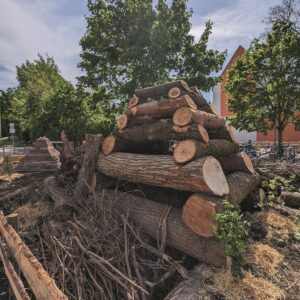 Deadwood is one of the most valuable habitats in nature. Deadwood refers to dead branches on an old tree as well as dead trees and roots or parts of them. It serves as a food source, habitat, nesting place and building material for countless insects and other invertebrates.
Deadwood is one of the most valuable habitats in nature. Deadwood refers to dead branches on an old tree as well as dead trees and roots or parts of them. It serves as a food source, habitat, nesting place and building material for countless insects and other invertebrates.
Rotting wood is also the basis of life for fungi, lichens, mosses and algae, on which other animals depend. Old wood that decomposes in nature ensures the survival of numerous insect species, such as the blue-black wood bee, the giant wood wasp, the rose chafer and the stag beetle. Around 1,350 beetle species in Central Europe alone depend on old or dead wood at some stage of their development. It is particularly important to leave the deadwood lying around for many years so that the natural decomposition processes can take place in all stages, including the formation of mulch and humus.
Pruning trees and shrubs also produces a lot of wood in the garden. Instead of disposing of the dead wood, the prunings can be wonderfully incorporated into decorative garden design. Whether it’s bed edging, climbing aids, branch piles or privacy screens – there are no limits to your creativity. Larger deadwood walls or Benjes hedges are popular nesting sites, e.g. for wrens. In addition, new material can be piled up again and again, as the wood piles settle during the decomposition process.
Water is life – The small pond
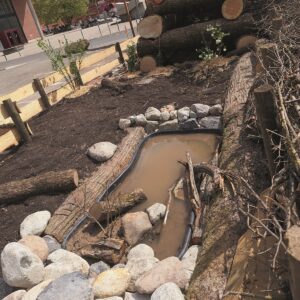 In addition to pollen and nectar, some native bee species, such as the thighed bees, also collect oil from the flowers of the purple loosestrife. The saw horn bee specializes in the pollen of the purple loosestrife. These plants grow mainly on the banks of watercourses and in marshes, which are endangered habitats in the cultivated landscape. As a result, the bee species that depend on these plants are also endangered.
In addition to pollen and nectar, some native bee species, such as the thighed bees, also collect oil from the flowers of the purple loosestrife. The saw horn bee specializes in the pollen of the purple loosestrife. These plants grow mainly on the banks of watercourses and in marshes, which are endangered habitats in the cultivated landscape. As a result, the bee species that depend on these plants are also endangered.
A near-natural pond therefore provides an important habitat for many native amphibians, insects, water and marsh plants. Many beneficial insects are also dependent on the habitat. For example, birds like to use the waterhole for bathing and quench their thirst there, as do other small mammals and insects. Wild bees collect the semi-dry
mud to close their breeding tubes, while amphibians find safe cover between the plants. And people benefit from a cooler microclimate during hot spells due to the slow evaporation of the water.
New walls made from old stones – dry stone walls
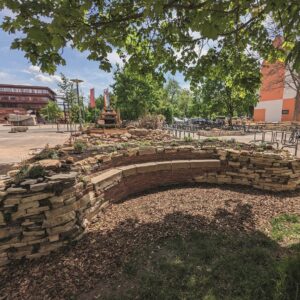 The ecological value of a dry stone wall is not measured by the material used, but rather by its structural diversity. So it doesn’t have to be the most expensive natural stone; any material that can be stacked to form a stable wall can be used.
The ecological value of a dry stone wall is not measured by the material used, but rather by its structural diversity. So it doesn’t have to be the most expensive natural stone; any material that can be stacked to form a stable wall can be used.
But dry stone walls have become rare. Created by man, they have also fallen victim to man again. They have been replaced by concrete walls, solid-walled enclosures and hunting fences – and their inhabitants have disappeared along with the walls. If they still exist, the structures are often left to decay and soon there is little left of them. In addition to the preservation and maintenance of existing walls, it would therefore be important to reintroduce the dry stone wall as an invigorating element in gardens.
Manfred Rother (an expert in upcycling dry stone walls) has been committed to this goal for over 40 years. In collaboration with him, several smaller and larger walls have been built here at the FAU WiSo Oasis. These dry stone walls were built exclusively from upcycling materials. Old clinker bricks, limestone house demolition, granite worktops, sandstone from a former house … a colorful mixture that is also reflected in the character of the walls. No two stones are alike, with saxifrage, houseleek, sedum and thyme growing out of the gaps. The cracks between the stones also provide a fascinating habitat for many animal species. Recycled dry stone walls therefore not only promote ecological diversity or impress with their visual highlights, but also save and bind a lot of CO2.
A new castle in the city – the lizard castle
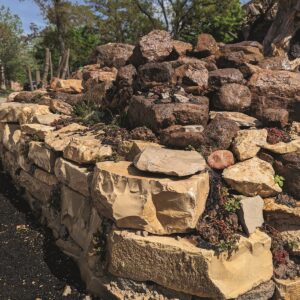 The western green lizard, sand lizard, wall lizard and common lizard are among the best-known lizard species in Germany, including the slow worm. Like many other wild animals, these fascinating creatures are endangered.
The western green lizard, sand lizard, wall lizard and common lizard are among the best-known lizard species in Germany, including the slow worm. Like many other wild animals, these fascinating creatures are endangered.
As cold-blooded animals, lizards need warm places with many hours of sunshine, such as south-facing rock piles, to regulate their body temperature. They feed on beetles, flies, woodlice, millipedes and grasshoppers, among other things. A colorful garden with wild shrubs, flower meadows, etc. therefore offers a rich supply of insects, which is essential for lizards.
Lizards need sufficient moisture for their regular moulting. They therefore like to seek out vegetation-rich shallow pond banks or swamp beds. Lizards bury their eggs in warm places in loose, sandy soil, often protected under tree roots or stones. The young hatch after about 2-3 months. In contrast, forest lizards give birth to their offspring alive. For hibernation, lizards need a frost-free pit filled with pieces of wood, branches and larger stones as a shelter for the 6-month hibernation period. The lizard castle is designed to create the best possible conditions for lizards. The stones used are recycled field stones from a local farmer.
However, as the animals only have a small radius of action of a few hundred meters, immigration is rather unlikely unless there is a population nearby.